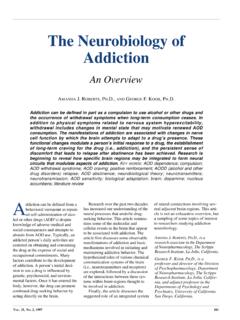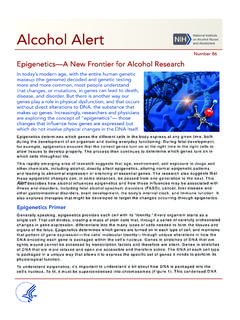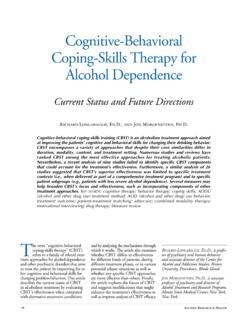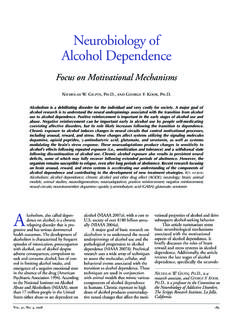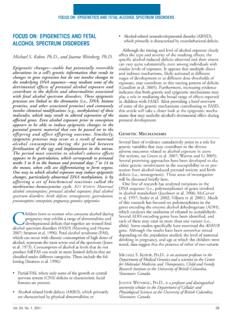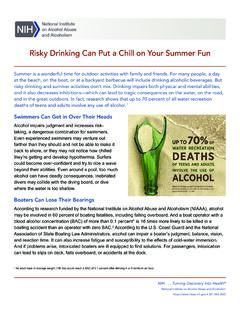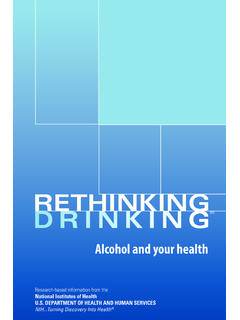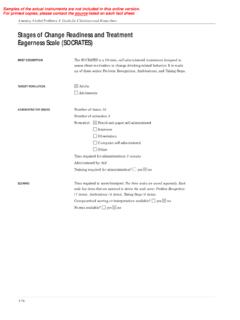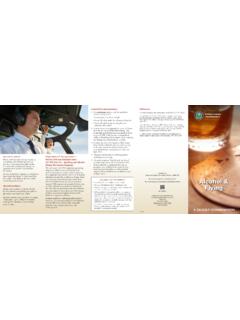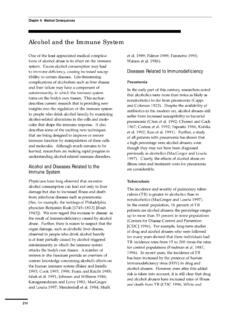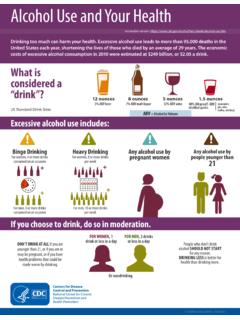Transcription of Alcohol and Medication Interactions
1 Alcohol and MedicationInteractionsRon Weathermon, , and David W. Crabb, medications can interact with Alcohol , thereby altering the metabolism or effects ofalcohol and/or the Medication . Some of these Interactions can occur even at moderatedrinking levels and result in adverse health effects for the drinker. Two types of Alcohol - Medication Interactions exist: (1) pharmacokinetic Interactions , in which Alcohol interfereswith the metabolism of the Medication , and (2) pharmacodynamic Interactions , in whichalcohol enhances the effects of the Medication , particularly in the central nervous system( , sedation).
2 Pharmacokinetic Interactions generally occur in the liver, where both alcoholand many medications are metabolized, frequently by the same enzymes. Numerous classesof prescription medications can interact with Alcohol , including antibiotics, antidepressants,antihistamines, barbiturates, benzodiazepines, histamine H2receptor antagonists, musclerelaxants, nonnarcotic pain medications and anti-inflammatory agents, opioids, and addition, many over-the-counter and herbal medications can cause negative effects whentaken with Alcohol . KEYWORDS: moderate AOD use; prescription drug; adverse druginteraction; drug metabolism; ethanol metabolism; cytochromes; liver; alcoholdehydrogenases; antibiotics; antidepressants; histamine H1 receptor blockaders; barbiturates;benzodiazepines; histamine H2 receptor blockaders; anti-inflammatory agents; opioids;warfarin; over-the-counter drug; literature reviewMost people who consumealcohol, whether in moderateor large quantities, also takemedications, at least occasionally.
3 As aresult, many people ingest alcoholwhile a Medication is present in theirbody or vice versa. A large number ofmedications both those availableonly by prescription and those avail-able over the counter (OTC) havethe potential to interact with Interactions can alter the meta-bolism or activity of the medicationand/or Alcohol metabolism, resultingin potentially serious medical consequences. For example, the sedative effects of both Alcohol andsedative medications can enhanceeach other ( , the effects are addi-tive), thereby seriously impairing aperson s ability to drive or operateother types of machinery. Most studies assessing Alcohol - Medication Interactions focus on theeffects of chronic heavy limited information is avail-able, however, on Medication interac-tions resulting from moderate alcoholconsumption ( , one or two standarddrinks1per day).
4 Researchers, physi-cians, and pharmacists must thereforeinfer potential Medication interactionsat moderate drinking levels based onobservations made with heavy addition, moderate Alcohol consump-tion may directly influence some ofthe disease states for which medicationsare taken (see sidebar, pp. 52 53, forfurther discussion of Alcohol s influ-ences on various disease states). This40 Alcohol Research & Health RONWEATHERMON, , is anassistant professor at the School ofPharmacy and PharmaceuticalSciences, Purdue University,Indianapolis, CRABB, , is a professorin the Departments of Medicine andBiochemistry and Molecular Biology,Indiana University School of Medicine,Indianapolis, standard drink is defined as one 12-ounce canof beer or bottle of wine cooler, one 5-ounce glassof wine, or ounces of distilled spirits and isequivalent to approximately ounce, or 12grams (g), of pure discusses Alcohol absorption,distribution, and metabolism withinthe body; the sites where potentialalcohol- Medication Interactions canoccur.
5 And possible adverse effectsfrom various Alcohol -medicationcombinations, including OTC orherbal products. Alcohol Absorption,Distribution, andMetabolismGastrointestinal Absorption and MetabolismWhen Alcohol is ingested through themouth, a small amount is immediatelybroken down ( , metabolized) in thestomach. Most of the remaining alcoholis then absorbed into the bloodstreamfrom the gastrointestinal tract, primar-ily the stomach and the upper smallintestine. Alcohol absorption occursslowly from the stomach but rapidlyfrom the upper small intestine. Onceabsorbed, the Alcohol is transported tothe liver through the portal vein. Aportion of the ingested Alcohol ismetabolized during its initial passagethrough the liver; the remainder ofthe ingested Alcohol leaves the liver,enters the general ( , systemic) cir-culation, and is distributed through-out the body s tissues.
6 Alcohol metabolism (or the meta-bolism of any other substance) thatoccurs in the gastrointestinal tract andduring the substance s initial passagethrough the liver is called first-passmetabolism (see figure 1). For exam-ple, the mucosa lining the stomachcontains enzymes that can metabolizealcohol as well as other substances;some of those enzymes, includingalcohol dehydrogenase (ADH) andcytochrome P450 are described inmore detail in the section AlcoholMetabolism in the Liver. The contribution of stomach ( ,gastric) enzymes to first-pass alcoholmetabolism, however, is some researchers have pro-posed that gastric enzymes play a majorrole in first-pass metabolism (Lim etal.)
7 1993), other investigators considerthe liver to be the primary site of first-pass metabolism (Levitt and Levitt1998). Furthermore, some gender dif-ferences appear to exist in the overallextent of, and in the contribution of,gastric enzymes to first-pass meta-bolism. For example, the extent offirst-pass metabolism is less in womenthan in men and some studies alsoWhat Is Moderate Drinking?Vol. 23, No. 1, 199941 Alcohol and Medication InteractionsFigure 1 Schematic representation of first-pass metabolism. (A) Alcohol ingested through the mouth reaches the stomach, wherea portion is metabolized by the enzyme Alcohol dehydrogenase (ADH). The remaining Alcohol enters the intestine, wheremost of the remainder is absorbed into the bloodstream and enters the portal vein that leads to the liver.
8 In the liver, partof the Alcohol is metabolized by ADH or cytochrome P450. The remaining Alcohol enters the general ( , systemic)circulation and eventually is transported back to the liver and metabolized there. The metabolism of Alcohol in the stomachor during the first passage through the liver after absorption from the intestine is called first-pass metabolism. (B) Changesin blood Alcohol levels (BALs) after oral Alcohol ingestion and after intravenous administration of the same Alcohol difference in BALs achieved with both administration routes ( , the amount by which the BAL is lower after oralingestion) represents that portion of the ingested Alcohol that has been broken down by first-pass metabolism beforereaching the systemic circulation.
9 Hepatic metabolism of Alcohol (possibly blocked by some medications)StomachIncreased gastric emptying (stimulated or inhibited by some medications) Alcohol absorption into bloodstreamPortal VeinTransgastric metabolism (possibly blocked by some medications) Alcohol to systemic circulationLiverAlcohol010203040504321 HoursBAL (mg %)Intravenous alcoholOral alcoholIntestinePanel APanel B42 Alcohol Research & Health have found lower gastric ADH activityin women (Thomasson 1995). First-pass metabolism is readilydetectable after consumption of lowalcohol doses2that leave the stomachslowly ( , because they have beenconsumed with a meal). Thus, undersuch conditions of delayed gastric emp-tying, more Alcohol can be metabolizedin the stomach or absorbed slowlyfrom the stomach and transported tothe liver for first-pass metabolism.
10 In general, probably only a small frac-tion (perhaps 10 percent) of ingestedalcohol is eliminated from the bodyby first-pass metabolism after consump-tion of low doses of Alcohol . As alcoholingestion increases, the amount of alco-hol eliminated by first-pass metabolismbecomes an even smaller fraction ofthe total amount of Alcohol researchers have suggested, how-ever, that some medications can blockfirst-pass metabolism, resulting inblood Alcohol levels (BALs) that arehigher than normal for a given alcoholdose. For example, people taking med-ications that can inhibit ADH activity such as aspirin and certain medicationsused to treat ulcers and heartburn ( ,H2receptor antagonists, such as cime-tidine [Tagamet ], nizatidine [Axid ]and ranitidine [Zantac ]) experiencereduced first-pass metabolism (Caballariaet al.)

